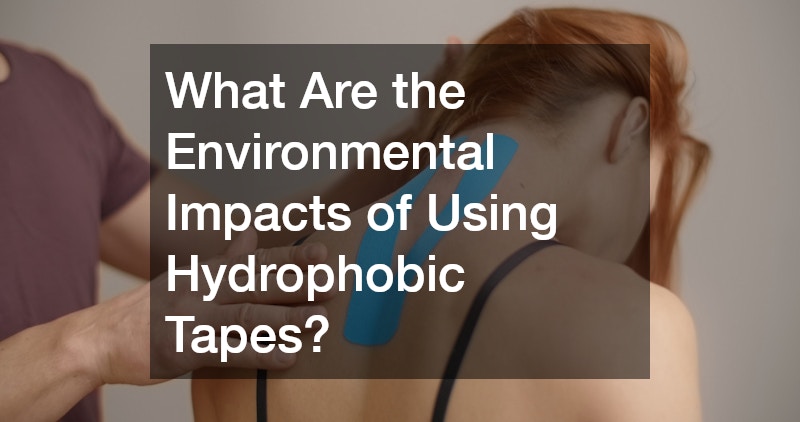In today’s world, the demand for innovative materials that offer superior protective solutions is ever-growing. Hydrophobic tapes, with their water-repellent properties, have emerged as a versatile option for various applications. This article explores the advantages and uses of hydrophobic tapes, providing insights into why they are becoming a go-to choice for professionals across different industries.
How Do Hydrophobic Tapes Work?
Principles of Hydrophobicity
Hydrophobicity is based on the ability of a surface to repel water, creating a barrier that prevents water molecules from adhering. This principle is essential in hydrophobic tapes, allowing them to provide effective waterproofing solutions.
Through the manipulation of surface energy and textures, hydrophobic tapes create a contact angle that causes water to bead up and roll off. This scientific approach ensures that the tapes maintain their effectiveness even in extreme conditions.
Often compared to the natural water-repelling characteristics found in plants like the lotus leaf, hydrophobic tapes utilize similar principles. The practical application of these principles in tape technology enhances performance across multiple sectors.
Design and Composition
The design of hydrophobic tapes involves a combination of specialized coatings and materials engineered to maximize water repellency. By carefully selecting polymers and adhesive substances, manufacturers achieve optimal hydrophobicity.
Some tapes incorporate micro-scale and nano-scale patterns on their surfaces, increasing their ability to repel water and other liquids. These patterns minimize the contact area between the tape surface and the liquid, boosting efficiency.
Additionally, the use of advanced composite materials has further enhanced the durability and weather resistance of hydrophobic tapes. This composition allows the tapes to provide long-lasting performance under various environmental conditions.
What Are the Applications of Hydrophobic Tapes?
Industrial Applications
In the industrial sector, hydrophobic tapes are employed to protect machinery and components from moisture damage and corrosion. These tapes improve operational efficiency by minimizing downtime and maintenance needs.
Electrical insulation is another critical use, where hydrophobic tapes prevent moisture accumulation that could lead to short circuits. By ensuring equipment reliability, industries experience fewer disruptions and safer work environments.
The automotive industry also benefits, using hydrophobic tapes in the assembly and protection of vehicle components. These applications extend the lifespan of parts exposed to harsh weather, contributing to sustainability.
Consumer Uses
In everyday life, hydrophobic tapes offer numerous benefits, from repairing household leaks to providing waterproof seals for outdoor gear. With user-friendly designs, these tapes make at-home fixes quick and effective.
For creative projects, such as DIY crafts and outdoor decorations, hydrophobic tapes offer robust protective features without compromising aesthetics. Consumers value these tapes for their combination of functionality and accessibility.
Wearable technology also utilizes hydrophobic tapes to safeguard devices from sweat and environmental exposure. This ensures longevity and performance, meeting modern consumers’ demands for reliability.
Are Hydrophobic Tapes Durable?
Factors Affecting Longevity
Several factors influence the durability of hydrophobic tapes, including the quality of materials used and environmental exposure. Regular stress tests and material innovations contribute to enhanced lifespan.
Adhesion strength plays a crucial role in determining how long a tape remains effective. High-quality adhesives that resist temperature fluctuations and UV radiation extend the tape’s functional period.
Proper storage and application techniques also impact longevity. By following manufacturer guidelines, users can ensure that hydrophobic tapes retain their protective attributes over time.
Comparison with Other Waterproofing Solutions
When compared to traditional waterproofing solutions, hydrophobic tapes offer advantages in terms of flexibility and convenience. Their easy application makes them ideal for both permanent and temporary solutions.
While liquid sealants and sprays may degrade over time, hydrophobic tapes typically maintain their integrity longer. The durability of these tapes reduces replacement frequency, offering cost-effectiveness.
Testing indicates that hydrophobic tapes can endure diverse environments, retaining functionality in conditions where other solutions might fail. This resilience makes them suitable for various challenging applications.
How to Choose the Right Hydrophobic Tape?
Considerations for Selection
When selecting a hydrophobic tape, it’s essential to consider the specific needs of your application. Factors such as environmental exposure and required adhesion strength should guide your choice.
Compatibility with the surface material is crucial for ensuring optimal performance. Users should assess whether the tape will adhere effectively to the intended substrate.
Additionally, the tape’s thickness and flexibility can affect usability, particularly in applications requiring conformability to irregular surfaces. Evaluating these characteristics helps ensure the best fit for your needs.
Understanding Specifications
Comprehending product specifications ensures that you select a hydrophobic tape capable of performing under expected conditions. Key specs include adhesion strength, temperature rating, and water resistance levels.
Consulting specification sheets allows users to match the tape’s capabilities with their specific application requirements. This specification alignment promotes effective and reliable use.
Where possible, seeking expert advice or product demonstrations can further aid in understanding the suitability of a particular hydrophobic tape. This practical insight supports informed decision-making.
What Are the Environmental Impacts of Using Hydrophobic Tapes?
Eco-Friendly Options
Many manufacturers now offer hydrophobic tapes that are environmentally friendly, made from sustainable or recyclable materials. These options reduce ecological footprints while retaining performance.
Switching to eco-friendly tapes can support corporate sustainability goals and consumer environmental consciousness. As demand grows, more companies are innovating within this space.
The availability of biodegradable adhesives further enhances the ecological benefits of hydrophobic tapes. These eco-conscious choices align with broader environmental priorities, promoting responsible usage.
Recycling and Disposal
Proper recycling and disposal practices are vital for minimizing the environmental impact of hydrophobic tapes. Users should adhere to local regulations regarding the recycling of composite and adhesive materials.
Some manufacturers provide take-back programs or recycling instructions to facilitate eco-friendly disposal. Engaging with these resources helps mitigate environmental harm.
Raising awareness about the environmental aspects of hydrophobic tapes can encourage responsible consumer behavior. Community education initiatives emphasize the importance of sustainable material use and disposal.

